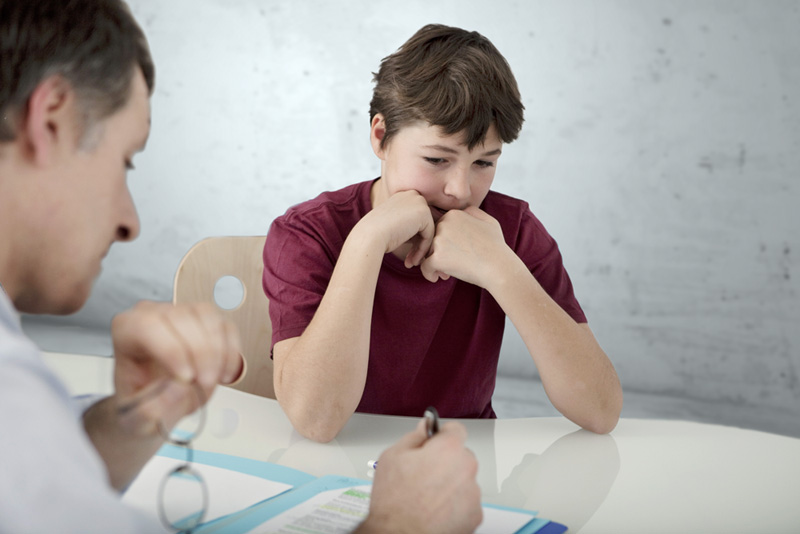How is teaching in a juvenile correction setting different from teaching in a public school setting?
Page 2: Intake and Treatment Plan Procedures
 Youth entering JC facilities undergo an intake process. Though these differ depending on the facility and the state in which it is located, the general procedures are relatively consistent. As part of the intake process, a case manager meets with the youth to:
Youth entering JC facilities undergo an intake process. Though these differ depending on the facility and the state in which it is located, the general procedures are relatively consistent. As part of the intake process, a case manager meets with the youth to:
- Review the rules of the facility
- Conduct assessments on the student’s academic, behavioral, and mental health needs
- Create and discuss the student’s schedule of classes, recreation time, and services
- Discuss the student’s individual academic needs (e.g., whether the student was receiving special education services)
- Identify other necessary supports (e.g., anger-management training, Narcotics Anonymous meetings)
To allow for accurate planning and meaningful support, it is important to obtain the student’s school records as quickly as possible. This is particularly beneficial for students with disabilities who have individual education programs (IEP) that must be followed when in juvenile corrections.
individualized education program (IEP)
A written plan used to delineate an individual student’s current level of development and his or her learning goals, as well as to specify any accommodations, modifications, and related services that a student might need to attend school and maximize his or her learning.
Did You Know?
Family Educational Rights and Privacy Act (FERPA) is a law the purpose of which is to protect the privacy of a student’s educational records. To comply with FERPA, schools require a parent’s or guardian’s signature to release a student’s educational record. What is not commonly recognized is that FERPA has explicitly included juvenile correctional facilities in the definition of “educational programs” to facilitate the exchange of educational records.
Family Education Rights and Privacy Act (FERPA)
Federal legislation in the United States that protects the privacy of students’ personally identifiable information (PII). The act applies to all educational institutions that receive federal funds.
Once this information has been collected, the next step is to develop an individual treatment plan—a brief document outlining the actions the student is required to complete in order to be released from the facility. A good initial plan will serve to prevent challenges that could arise during the student’s time in the facility. The sooner the student begins following the plan, the more productive his or her time in the JC setting will be. This is usually developed by a multi-disciplinary transition or reintegration team—typically consisting of the youth, her or his family members or guardians, and a number of different professionals, for example the student’s case manager, parole officer, teachers, mentor, and related services providers.
related services
A part of special education that includes services from professionals (e.g., occupational therapist [OT], physical therapist [PT], Speech-Language Pathologist [SLP]) from a wide range of disciplines typically outside of education, all designed to meet the learning needs of individual children with disabilities.
measurable goals
Short-term or long-term objectives that are clearly defined in such a way that they are observable and easy to determine if and when they have been met.
benchmark
A typical or expected performance level in a given skill (e.g., reading) that serves as a general indicator of a student’s overall progress.
Taking into account the youth’s length of stay at the facility, appropriate measurable goals, benchmarks, and rewards should be included in the individual treatment plan. If the student has an IEP, and it is available, these goals and benchmarks should align with those outlined in the IEP. Obtaining input from the student and focusing on goals he or she wishes to accomplish will increase the likelihood of success. Staff can determine whether the youth has made progress toward reaching a specific goal by establishing benchmarks. Each time the youth achieves a benchmark, he or she receives a reward. Rewards commonly include completion certificates from programs the students have taken part in during their stay, for example life skills, anger management, or vocational training programs. Certificates can be kept in a portfolio to demonstrate individual progress in the program. Click the link below to view a sample individual treatment plan.
Sample Individual Treatment Plan
Robert White was incarcerated for a number of years in a juvenile corrections facility. Listen as he describes how, as part of the individual treatment plan, his teacher collected data and established individualized instructional goals (time: 0:30).
Robert White
Former incarcerated youth

Transcript: Robert White
In the youth facility, the teacher would start off on a test to see where everyone’s at. From there, she would make specific plans for every individual. Then she went around and taught individually. “This is how you go about doing it, and if you need more help I can help you.” And then she also had a student helper help the ones that are under. They helped us come up with goals. It was more-or-less, like, “This week, you’re here. Let’s try to get here. Let’s see how you do.”
For Your Information
A student’s individual needs and length of stay in a facility influences the kinds of academic goals she or he is able to achieve (e.g., credit recovery toward high school math classes, earning a high school equivalency diploma).
- The length of time youth spend in JC settings varies. A student might be detained for up to 60 days, 90 days, 120 days, or 180 days or longer. The individual treatment plan must establish goals that can be successfully accomplished during the time the student will be in the JC facility.
- In jurisdictions where the agency has control over release dates, completion certificates from programs the students have participated in during their stay can earn them early release.
There are benefits and challenges to obtaining student records quickly, even with the most current electronic record systems. Peter Leone discusses these briefly (time: 1:09).

Peter Leone, PhD
Professor, Department of Counseling, Higher Education & Special Education
University of Maryland
Transcript: Peter Leone, PhD
In some jurisdictions, where they have a well-developed system of electronic records and where the staff and the juvenile justice agency have the same kind of access that any public school would have to those records, it’s really seamless. They need the kid’s name and the last school district that the kid was in perhaps, and they go and they do a search and they see whether the kid was enrolled in special education. They see whether the kid is an English-language learner. They determine whether the kid has been retained. They identify a number of things that are important for scheduling and planning services for youth. That’s when it works well.
When it doesn’t work well, of course, you have lengthy delays. Even in good systems, you often have serious problems over the summer, when records clerks or people that transmit the kind of data that are needed to provide continuity in planning for a student’s education program, and those people are on vacation, and there often is nobody there. So that’s also a serious problem.